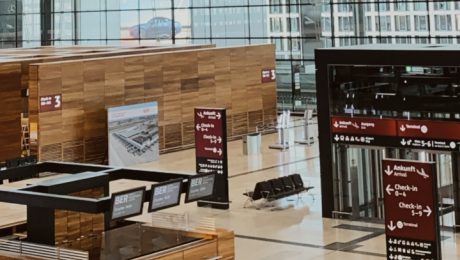Why airports and airlines should stay passenger-centric during the COVID-19 Pandemic
The aviation industry is one of the industries most affected by the corona crisis. The number of passengers dropped dramatically, to figures from over a decade ago. Airlines and Airports are forced to switch to survival mode. Although it is still important, to make sure passengers feel no less welcome than before the COVID-19 Pandemic.
As the Corona crisis first hit the aviation industry, airlines immediately cut into their flying schedule. Instead of multiple flights, a day between 2 cities, this was reduced to just one or two a day. At the same time, multiple routes were temporarily or permanently closed. At airports, terminals or parts of terminals were closed to answer the fallen demand in air travel. All measures which do not hurt the relationship between the airport, the airlines, and their passengers.
Most passengers that are flying during the pandemic, are passengers that were flying on a regularly basis, also before the COVID-19 pandemic. In other words, frequent flyers, who are often loyal to one or more airlines. These passengers demand high standards and expect to get the pre COVID-19 standards where possible. These passengers constitute a substantial group that will always have the need to fly.
Lowering standards unnecessarily is creating a lot of distrust between the passengers and the airline or airport. That distrust can lead to a decreased passenger loyalty and could cause a drop in passenger numbers for that particular airline or airport, even when the crisis is long over. Saving money on your customers service makes passengers more likely to consider other options. This is true for the occasional traveler, but also especially for frequent flyers who are likely to keep flying. You don’t want these to be taken away by competitors, who keep their standards high. As the saying says: “In times of crisis we find out who our true friends are”.
A crisis not only brings difficulties, but it is also a time full of opportunities. If you manage to exceed passenger expectations, you can bind passengers who were loyal to another airline or airport. A positive review, a comment on social media, can also influence other travelers.
In conclusion, even though in crisis, cuts and savings are inevitable, it is still highly important to stay passenger-centric, as the benefits outweigh the costs on when viewed in the long term. In the aviation sector competition is fierce, even in times of crisis. If an airport or an airline takes the wrong decisions, it will cost them even more in the long run.
- Published in Insights, Passenger Experience
Why an outside perspective is essential to successfully enhance passenger experience
A passenger is not a direct customer of an airport, but that does not mean he cannot become one. That is why an airport needs to take a passenger-centric approach and gather insights through the eyes of the passengers. To achieve this, an outside perspective is essential.
Airports that do not focus on their passengers are not only loosing opportunities, but also risk to waste a lot of cost due to pointless investments. In times were non aeronautical revenue is becoming an ever bigger share of an airports’ total revenue, taking a passenger-centric approach is essential to an airports’ success. The first step in this process is to view themselves through the eyes of their passengers in order to get an insight in their passengers and their experiences.
In order to get insights into the experience of passengers, an airport needs help from outside. In fact, it is impossible to evaluate yourself from the inside. It is a natural thing that organisations get a tunnel vision, which makes it impossible to see things clearly. To counteract this natural process, an outside perspective is needed, while it is objective and will counteract bias from the inside, from group thinking, or internal politics. It is easy to see that the view is often clearer from the outside than the inside.
It is verry important that airports select the right partner, which does not carry any internal baggage. These independent firms do not need to be experts in the airports’ day to day operations, but can bring more experience and a broader palette of specializations. Those specialists can serve as a bridge between the airport and its passengers, and will bring airports out of their comfort zone. Because let’s be honnest, nothing realy good has ever been created within our comfort zone.
Finally although an outside perspective is essential, it does not end there. Enhancing passenger experience shall be a joint effort between the airport, its passengers, and external partners.
- Published in Insights, Passenger Experience
Where passenger experience surveys fail
Airports and airlines want to create experiences that make their customers stay longer, buy more and positively refer others. To achieve this, it is essential to know what passengers really want and need. But while regularly sending out basic surveys may help, this is not enough to make you really understand your passenger’s needs. Despite their advantages, surveys can be misleading or leave gaps in the insights that airlines and aiports need. Here is a list of ways in which surveys can fall short:
1. Non-response bias
One common problem with surveys is that response rates are low, and you hear mainly from those who are extremely satisfied or extremely bitter about their experience. This is not a representative sample. This bias is called a non-response bias, and occurs because there are distinct differences between the people who respond and those who don’t respond. This can result in misleading or inaccurate data. The higher the response rate of a survey the lower the risk of non-response bias. If not designed correctly, other kinds of biases may also occur. For example, a five-point rating scale with 3 or more positive rating points will result in ‘false’ positives.
2. Only information from the current customers
All too often, companies only survey current customers. In this way, they find out why they are customers, but learn little or nothing about those who are not customers, and who have found greater value elsewhere. It is therefore extremely important to also collect data from past customers, and if possible even from people who have never been customer before. In this respect, it can also be interesting to hire an outside expert or consultant, as they are experienced and can compare services and standards between different organizations.
3. Difficult to determine what customers want for the future
Asking for feedback on the current services, will only yield feedback on the current way of operating. This is useful for process improvement, but not for future-oriented strategic development. Moreover, it is much easier to determine what customers want now, than what they will want in the future. Customers may not even know what is possible or what they will want in the future. Yet it is vital to determine this and anticipate those future wants and needs.
4. From data to action
While surveys can give you useful information, many organizations struggle with turning these results into action. The results won’t provide you with the next steps necessary to enhance customer experience. Nor will it be clear which issues should be tackled first. Also, the data will tell you what is wrong… but they don’t tell you why. And the why is extremely important in developing new strategies for enhancing passenger experience. When a customer gives you the lowest rating, there is not much you can do with this information, unless you understand the rationale behind this score. The same holds for great scores: you need to know why, so you can replicate the same experience with other customers. Therefore, you will need additional information to understand why your customers are rating you the way they are.
Because of these pitfalls, it is important to include qualitative customer research, like for example in-depth interviews, focus groups, and mystery passenger services, to complement the quantitative data obtained by surveys. These tools provide an integrative view of the customer experience and can uncover valuable insights where surveys fall short. To summarize, the best basis for an effective customer experience strategy is a combination of quantitative and qualitative approaches.
- Published in Insights, Passenger Experience




